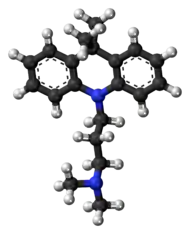 | |
 | |
| Clinical data | |
|---|---|
| Trade names | Istonil, Istonyl, Linostil, Miroistonil |
| Routes of administration | Oral |
| ATC code | |
| Legal status | |
| Legal status | |
| Identifiers | |
| |
| CAS Number | |
| PubChem CID | |
| DrugBank |
|
| ChemSpider | |
| UNII | |
| KEGG | |
| CompTox Dashboard (EPA) | |
| Chemical and physical data | |
| Formula | C20H26N2 |
| Molar mass | 294.442 g·mol−1 |
| 3D model (JSmol) | |
| |
Dimetacrine (brand names Istonil, Istonyl, Linostil, Miroistonil), also known as dimethacrine and acripramine, is a tricyclic antidepressant (TCA) used in Europe and formerly in Japan for the treatment of depression.[2][3][4][5][6] It has imipramine-like effects; though, in a double-blind clinical trial against imipramine, dimetacrine was found to have lower efficacy in comparison and produced more weight loss and abnormal liver tests.[7][8]
Little is known about the pharmacology of dimetacrine,[9] but it can be inferred that it acts in a similar manner to other TCAs. If this is indeed the case, dimetacrine may induce severe cardiac toxicity in overdose (a side effect unique to the tricyclic class of antidepressants).
See also
References
- ↑ Anvisa (2023-03-31). "RDC Nº 784 - Listas de Substâncias Entorpecentes, Psicotrópicas, Precursoras e Outras sob Controle Especial" [Collegiate Board Resolution No. 784 - Lists of Narcotic, Psychotropic, Precursor, and Other Substances under Special Control] (in Brazilian Portuguese). Diário Oficial da União (published 2023-04-04). Archived from the original on 2023-08-03. Retrieved 2023-08-16.
- ↑ Dictionary of organic compounds. London: Chapman & Hall. 1996. ISBN 0-412-54090-8.
- ↑ Kato S (1993). "A Review of the Pharmacotherapy of Depression in Japan". In Kariya T, Nakagawara M (eds.). Affective Disorders: Perspective on Basic Research and Clinical Practice. Tokyo: Seiwa Shoten. ISBN 978-0-87630-674-1.
- ↑ Vela JM, Buschmann H, Holenz J, Párraga A, Torrens A (2007). Antidepressants, Antipsychotics, Anxiolytics: From Chemistry and Pharmacology to Clinical Application. Weinheim: Wiley-VCH. ISBN 978-3-527-31058-6.
- ↑ Taen S, Pöldinger W (December 1966). "[Dimethacrine (istonil), an acridane derivative with the antidepressive action]". Schweizerische Medizinische Wochenschrift (in German). 96 (48): 1616–1620. PMID 6008540.
- ↑ Meyer R (May 1968). "[Contribution to the clinical evaluation of the antidepressive effect of dimethacrine (Istonil)]". Praxis (in German). 57 (20): 721–723. PMID 5756370.
- ↑ Abuzzahab FS (November 1973). "A double-blind investigation of dimethacrine versus imipramine in hospitalized depressive states". International Journal of Clinical Pharmacology, Therapy and Toxicology. 8 (3): 244–253. PMID 4149236.
- ↑ Mutschler E, Derendorf H (1995). "Psychoactive Drugs: Antidepresants". Drug actions: basic principles and therapeutic aspects. Stuttgart, Germany: Medpharm Scientific Pub. ISBN 0-8493-7774-9. Retrieved January 30, 2013.
- ↑ "Dimetacrine". PubChem. U.S. National Library of Medicine. Retrieved 2023-11-03.
| |||||||||||||||||||||
| |||||||||||||||||||||
| |||||||||||||||||||||
| |||||||||||||||||||||
| |||||||||||||||||||||
| Classes | |
|---|---|
| Antidepressants (Tricyclic antidepressants (TCAs)) |
|
| Antihistamines |
|
| Antipsychotics |
|
| Anticonvulsants | |
| Anticholinergics | |
| Others |
|
This article is issued from Wikipedia. The text is licensed under Creative Commons - Attribution - Sharealike. Additional terms may apply for the media files.